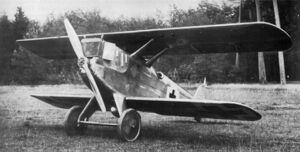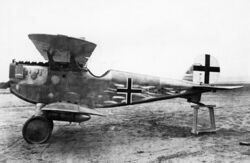Engineering:Dornier-Zeppelin D.I
| D.I | |
|---|---|

| |
| Role | Single-seat fighter |
| National origin | Germany |
| Manufacturer | Zeppelin-Lindau |
| Designer | Claude Dornier |
| First flight | 4 June 1918[1] |
| Status | Abandoned |
| Primary user | Luftstreitkräfte |
| Number built | 7 |
| Developed into | Dornier Do H Falke |
The Zeppelin D.I, or Zeppelin-Lindau D.I or Zeppelin D.I (Do) (as named in German documents), also sometimes referred to postwar as the Dornier D.I or Dornier-Zeppelin D.I, for the designer,[2] was a single-seat all-metal stressed skin[3][4] monocoque[3] cantilever-wing biplane fighter,[3][4] developed by Claude Dornier while working for Luftschiffbau Zeppelin at their Lindau facility.[3] It was too late to see operational service with the German Air Force (Luftstreitkräfte) during World War One.
Development and design
The Dornier D.I was one of several designs by Claude Dornier to have an all-metal stressed skin[3] monocoque structure,[3] and it was the first fighter to feature such construction and although production was cancelled prior to the completion of any production versions, it was also the first aircraft with these features to go into production. To reduce the hazards of inflight fires, it also had an external fuel tank, which, according to some sources may have been jettisonable,[2][5] and thick-section cantilevered wings for improved aerodynamics. The Dornier Do H Falke was developed from it, but had an enlarged upper wing to compensate for the removal of the lower wing.
Operational history
Seven prototypes were built as part of the development program. It was never used operationally, due to the end of World War I. Luftstreitkräfte pilots evaluated the type in May and June 1918 and again in October.[6][7] German ace Wilhelm Reinhard was killed on 3 July 1918 after a structural failure, while it was supposed to have been grounded for structural improvements.[6] There were reports of heavy aileron controls and poor climb performance at higher altitudes. After being fitted with a more powerful BMW IIIa inline-six liquid-cooled engine that boosted the climb rate to 5,000 m (16,000 ft) from 25 minutes to 13 minutes, an order was placed for 50 aircraft either in October or November.[8] The airframes for this order were roughly 50 percent complete when production was halted in early 1919.[7] One of the prototypes went to the US Navy and another to the US Army Air Service, both purchased in 1921 and delivered in 1922, for evaluation of the novel construction methods used.[7]
Operators
 German Empire
German Empire
- Luftstreitkräfte - evaluation only
 United States
United States
- United States Navy - one example for evaluation, serialed A6058[9]
- United States Air Service - one example for evaluation, serialed AS.68546, McCook Field Project Number P.241[10][11]
Survivors/Aircraft on display
None of the examples built survive.
Specifications (BMW engine)
Data from Kössler, 1985, p.78
General characteristics
- Crew: One
- Length: 6.37 m (20 ft 11 in)
- Upper wingspan: 7.8 m (25 ft 7 in)
- Upper Wing chord: 1.4 m (4 ft 7 in)
- Lower wingspan: 6.5 m (21 ft 4 in)
- Height: 2.6 m (8 ft 6 in)
- Wing area: 18.7 m2 (201 sq ft)
- Empty weight: 725 kg (1,598 lb)
- Gross weight: 885 kg (1,951 lb)
- Powerplant: 1 × BMW IIIa , 138 kW (185 hp)
- Propellers: 2-bladed Axial[12], 2.7 m (8 ft 10 in) diameter wood fixed pitch propeller
Performance
- Maximum speed: 200 km/h (120 mph, 110 kn) at sea level
- Service ceiling: 8,100 m (26,600 ft)
- Time to altitude: 13 minutes to 5,000 m (16,000 ft)[8]
Armament
- 2 × 7.92 mm (0.312 in) fixed forward-firing LMG 08/15 Spandau machine guns
See also
Related development
- Dornier-Zeppelin C.II - two-seater with conventional wings but similar fuselage and developed roughly in parallel.
- Dornier Do H Falke
Aircraft of comparable role, configuration and era
- Fokker D.VII
- Junkers D.I (all metal fighter but not a monocoque)
- LFG Roland D.XV
- Pfalz D.XII
- Short Silver Streak (similar only in also having an early stressed skin monocoque structure)
Related lists
- List of fighter aircraft
- Idflieg aircraft designation system
- List of military aircraft of the Central Powers in World War I
References
Citations
- ↑ Grosz, 1998, p.8
- ↑ 2.0 2.1 Grosz, 1998, p.12
- ↑ 3.0 3.1 3.2 3.3 3.4 3.5 Grosz, 1998, p.0
- ↑ 4.0 4.1 Grey, 1970, p.580
- ↑ Kössler, 1985, p.78
- ↑ 6.0 6.1 Grosz, 1998, p.1
- ↑ 7.0 7.1 7.2 Grosz, 1998, p.10
- ↑ 8.0 8.1 Grosz, 1998, p.9
- ↑ Grosz, 1998, pp.3-4 and 8-10
- ↑ "1908-1921 USASC-USAAS Serial Numbers". Joseph F. Baugher. http://www.joebaugher.com/usaf_serials/1908-1920.html. Retrieved 1 October 2013.
- ↑ Grosz, 1998, pp.10-13
- ↑ Grosz, 1998, p.2
Bibliography
- Grosz, Peter (1998). Dornier D.I Windsock Mini datafile # 12. Hertfordshire, UK: Albatros Publications. ISBN 9780948414923.
- Gray, Peter; Thetford, Owen (1970). German Aircraft of the First World War (second ed.). London: Putnam. p. 580.
- Hundertmark, Michael; Steinle, Holger (1985) (in German). Phoenix aus der Asche - Die Deutsche Luftfahrt Sammlung Berlin. Berlin: Silberstreif Verlag. ISBN 978-3924091026.
- Kössler, Karl (1985) (in German). Dornier - Die Chronik des ältesten deutschen Flugzeugwerks. Friedrichshafen, Germany: Walter Biering GmbH. p. 78. ISBN 3-925505-01-6.
- Ogden, Bob (1983). Dornier - Flypast Reference Library. Lincs, England: Key Publishing. ISBN 0 946219 05 2.
- Sheppard, Milton (Winter 1968). "Dornier D.I Static Test". Cross & Cockade (Society of WW1 Aero Historians) 9 (4): 391–395.
- Terry, Gerard (1981). "The Development of Dornier Landplanes 1914-1918". Cross & Cockade Great Britain Journal (Society of WW1 Aero Historians) 12 (3): 97–117.
- unknown author (23 December 1920). "Some "Dornier" Milestones". Flight (Flight Magazine): 1269–1273 and pp.1289–1292.


